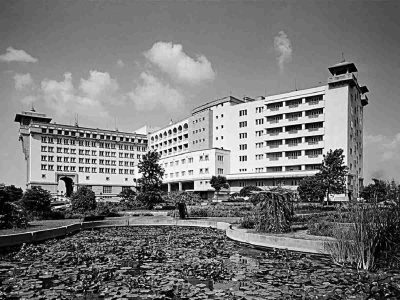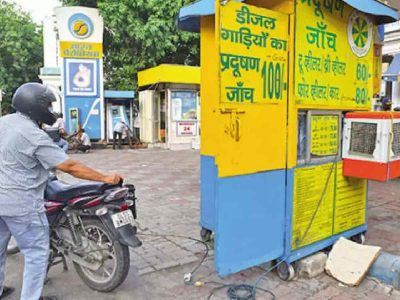As Delhi evolved in the years following independence, 1955 proved to be a landmark year in its architectural history. The city witnessed the construction of three iconic buildings that would go on to shape its institutional and diplomatic landscape—the Ashok Hotel, Dak Tar Bhawan, and Vigyan Bhawan. Now, 70 years later, these structures remain standing as silent witnesses to history, having hosted world leaders, political revolutionaries, and momentous events.
The Ashok Hotel was personally backed by Prime Minister Pt Jawaharlal Nehru, who saw the need for a world-class hotel in the capital. It was just one of several grand visions that materialised that year, alongside Vigyan Bhawan, built to host international conferences, and Dak Tar Bhawan, a modernist landmark designed to house the postal department.
From diplomatic summits to political intrigues, these three buildings have stories to tell—stories of a newly independent nation finding its voice on the world stage.
Delhi’s grand ambition: A new global identity
By the early 1950s, India was eager to establish itself as a prominent global player. New Delhi, the seat of power, needed modern infrastructure to reflect this ambition.
The 1956 UNESCO summit, a prestigious international event, became a catalyst. It was decided that a world-class convention centre and a premier hotel were required to host visiting dignitaries. This led to the creation of Vigyan Bhawan and the Ashok Hotel. Meanwhile, the rapidly expanding postal system demanded a modern headquarters, leading to the construction of Dak Tar Bhawan at Patel Chowk.
Each of these buildings, though serving different purposes, reflected a common goal—to project a confident, self-reliant India to the world.
Ashok Hotel: A symbol of Nehruvian India
For the Ashok Hotel, the government turned to Prof EB Doctor, a renowned Parsi architect from JJ College, Mumbai. Inspired by the grandeur of Lutyens’ Delhi, Doctor blended classical Mughal, Buddhist, and Hindu influences with modernist elements. The result was a striking hotel featuring grand jharokhas, jaali-work, and landscaped gardens.

S Utsav, a Delhi-based architect, explains:“Impressed with the work of the likes of Edwin Lutyens and Herbert Baker, Doctor had given space for jharokhas and jaali-work in the Ashok Hotel. He had also created a massive pillar-less convention hall, 550 guest rooms, and landscaped gardens.”
At the time, the only luxury hotels in Delhi were The Imperial and Hotel Oberoi Maidens. The Ashok Hotel changed that. It quickly became the preferred choice for heads of state, revolutionaries, and business tycoons.
Among its most famous guests, Che Guevara stayed at the Ashok Hotel during his only trip to Delhi in 1959. Fidel Castro made the Ashok his home during the 1983 NAM Summit, with three lookalikes positioned at the hotel to thwart potential attackers.
Velupillai Prabhakaran, the elusive Tamil Tigers leader, stayed here in the 1980s. Dhirubhai Ambani, in the early years of his business empire, always requested a room facing Nehru Park.
Bollywood superstar Rajesh Khanna was known to be particularly fond of the hotel.
Vigyan Bhawan: The epicentre of diplomacy
While the Ashok Hotel hosted world leaders, Vigyan Bhawan became the venue for India’s most crucial diplomatic and political events. RA Gehlote was tasked with its design. He merged elements of British colonial architecture with indigenous styles to create a stately yet functional convention centre.
What many may not know is that Vigyan Bhawan was built on the site of Maulana Azad’s former residence. The bungalow at 4 Edward Road (now Maulana Azad Road) was demolished after his passing to make way for the new structure.
For decades, Vigyan Bhawan remained Delhi’s primary conference hall, hosting landmark events ranging from international summits to major government meetings. Even today, it stands as a crucial hub for national and global diplomacy.
Dak Tar Bhawan: The beating heart of India’s postal system
Not as celebrated as the other two buildings, Dak Tar Bhawan nevertheless played a pivotal role in India’s communication revolution. The government entrusted Habib Rehman, one of India’s first modernist architects, to design it.

Arvind Kumar Singh, author of Bhartiye Dak, a book on Indian postal history, highlights its significance: “Dak Tar Bhawan is a very important building for the postal department of India. Even Lal Bahadur Shastri and Jagjivan Ram had their offices here when they were looking after the Communication Ministry. This building was Shastri’s office from 1957 to 1958.”\
For Rehman, his first major project in the capital was approached with meticulous detail, resulting in a building whose façade follows the curve of the roundabout and features an innovative layout ensuring natural light reaches every office. The design also included: “There is also a museum of postal stamps inside the building. Even Parliament Street Post Office is also there,” says Singh.
Located just outside Rafi Marg, the building stands as a landmark in India’s communication infrastructure.
While Dak Tar Bhawan was Habib Rehman’s breakthrough project, he went on to leave a significant mark on Delhi’s skyline with several other prominent buildings. In 1961, he designed Rabindra Bhavan, which became the headquarters of the Lalit Kala, Sangeet Natak, and Sahitya Akademis. He was also responsible for the construction of Vikas Minar and the AGCR Building, both of which became symbols of Delhi’s expanding bureaucracy.
Also Read: Secrets of the Delhi Assembly: Revolutionaries, a hidden tunnel, and a gallows room
Rehman’s distinct style of modernist functionality was evident in his designs for the Delhi Zoo, the UGC Building, and the RK Puram Sector-4 flats, which reflected his focus on practicality and efficiency. Another important project was the Mazar of Maulana Azad, where he played a crucial role in selecting Vanu Bhupa, a US-trained landscape architect, to design Rajghat.
His son, Ram Rehman, reflects on his father’s legacy: “Habib Rehman’s buildings, characterised by their modernist aesthetics and functional design, stand as testaments to his vision and talent.”
A lasting imprint on the capital
Seventy years after their construction, the Ashok Hotel, Vigyan Bhawan, and Dak Tar Bhawan remain integral to Delhi’s landscape. Each has evolved with time, adapting to new demands while preserving their historical significance.
Today, as Delhi continues to transform, these buildings stand as reminders of a time when India built not just structures, but aspirations





